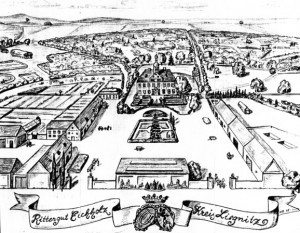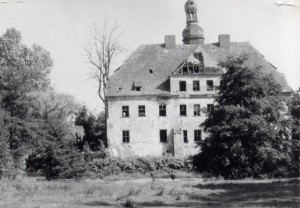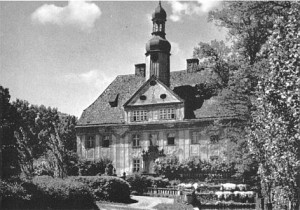HISTORY
Warmątowice Sienkiewiczowskie is a small village with an exceptionally interesting history. The first record of the village dates back to 1217. At that time it was a typical village populated by Polish nobility (szlachta), established around a central defensive mansion house, surrounded by a moat and a park. On the site of today’s palace a mansion house had existed since at least the 15th century.
 The original building was erected in 1602 – it was a Renaissance defensive mansion house, surrounded by a broad moat. The estate at first served as a border fortress of the Duchy of Legnica, given to the local knight’s family.
The original building was erected in 1602 – it was a Renaissance defensive mansion house, surrounded by a broad moat. The estate at first served as a border fortress of the Duchy of Legnica, given to the local knight’s family.
In 1748 the mansion house was transformed into a Baroque palace, whose structure has been retained to this day.
In 1812 the estate in Warmątowice was purchased by Ludwik Serafin von Olszewski.
His son, Alfred von Olszewski, owned the estate until 1909. He was a Germanized descendant of a noble family from eastern Poland, and after reading novels by Henryk Sienkiewicz (of course in a German translation) made a very unusual, even shocking last will and testament for his times. After his death, the estate was to be inherited by his children, provided that by the age of 30 they had passed an exam on Polish language, history and culture, and had married a Pole.
 In the event of non-compliance with this condition (or the premature death of the children) the estate was to go to Henryk Sienkiewicz or his heirs (after the death of the widow Olszewski). In no case could the property be transferred to the Prussian government or distant relatives. Olszewski’s last will and testament was presented to Sienkiewicz on 11 June 1909 in Cracow. It soon became obvious that the conditions set by the testator to his children would not be met. After the death of Olszewski, his widow, the German baroness Gabriela von Zedlitz und Neukirch, first tried to overturn the last will of her husband, but failing to do so she took up negotiations with Sienkiewicz. The Polish writer, who had never heard of the Olszewski family, did not accept the bequest, saying that one cannot be converted to Polishness under the threat of disinheritance. Gabriela von Olszewska only had to make a bank deposit of money, which she could withdraw when the condition expressed in the last will of her husband was fulfilled. Because the condition was not fulfilled, the deposit was passed later to a selected Polish educational organization. Alfred’s son, Bolesław Bogdan, died young, and the estate passed to his sister, Draga, who, interestingly enough, used her mother’s maiden name, von Zedlitz und Neukirch. The estate remained in the family until World War II and was destroyed at that time. Until the 1960s the palace was inhabited by various people, eventually became abandoned, and was taken over by the Polish state.
In the event of non-compliance with this condition (or the premature death of the children) the estate was to go to Henryk Sienkiewicz or his heirs (after the death of the widow Olszewski). In no case could the property be transferred to the Prussian government or distant relatives. Olszewski’s last will and testament was presented to Sienkiewicz on 11 June 1909 in Cracow. It soon became obvious that the conditions set by the testator to his children would not be met. After the death of Olszewski, his widow, the German baroness Gabriela von Zedlitz und Neukirch, first tried to overturn the last will of her husband, but failing to do so she took up negotiations with Sienkiewicz. The Polish writer, who had never heard of the Olszewski family, did not accept the bequest, saying that one cannot be converted to Polishness under the threat of disinheritance. Gabriela von Olszewska only had to make a bank deposit of money, which she could withdraw when the condition expressed in the last will of her husband was fulfilled. Because the condition was not fulfilled, the deposit was passed later to a selected Polish educational organization. Alfred’s son, Bolesław Bogdan, died young, and the estate passed to his sister, Draga, who, interestingly enough, used her mother’s maiden name, von Zedlitz und Neukirch. The estate remained in the family until World War II and was destroyed at that time. Until the 1960s the palace was inhabited by various people, eventually became abandoned, and was taken over by the Polish state.
In 1995 it was bought by a new private owner.
In February 1998 the name of the village was changed to Warmątowice Sienkiewiczowskie to commemorate the last will of the former palace owner.
 One interesting historic event that should be mentioned is the Battle of Katzbach (Bitwa nad Kaczawą), which took place on 26 August 1813 near the palace, on the fields surrounding the village, between Napoleon’s army and the Russo-Prussian Army of Silesia under the command of Field Marshal von Blücher. The palace was then the headquarters of the Field Marshal, and the two armies confronted each other unexpectedly on the local grounds. The battle ended in defeat for the French army, bringing Blücher the title of Prince of Wahlstatt (Legnickie Pole). From time to time a historical re-enactment is organized here to commemorate this battle.
One interesting historic event that should be mentioned is the Battle of Katzbach (Bitwa nad Kaczawą), which took place on 26 August 1813 near the palace, on the fields surrounding the village, between Napoleon’s army and the Russo-Prussian Army of Silesia under the command of Field Marshal von Blücher. The palace was then the headquarters of the Field Marshal, and the two armies confronted each other unexpectedly on the local grounds. The battle ended in defeat for the French army, bringing Blücher the title of Prince of Wahlstatt (Legnickie Pole). From time to time a historical re-enactment is organized here to commemorate this battle.
The last will and testament of Alfred von Olszewski:
“(…) though I write these words in German before a Prussian notary, today I feel like a Pole, and I am relieved by admitting the return to the faith and the traditions of my ancestors. Great merit for this has to be given to Henryk Sienkiewicz and his books, which awakened my conscience and national spirit. Today, when Teutonic arrogance makes its powerful return, when the Slavs are dispossessed of their heritage, I am harassed by the authorities and disliked by my neighbours. Therefore, I direct that my children, before they reach 30 years of age, pass 3 tests: in Polish language, culture and history, in front of a reliable examiner I have appointed. I direct that my daughter shall convert to Roman Catholicism. If these conditions are not met, I direct that my property, that is the village of Warmątowice (287 ha), generating a yearly income of 12927 marks, and the second property of 140 hectares, with an income of 5834 marks, as well as the palace in Warmątowice with an 8-hectare park, worth one million gold marks, are bequested to Henryk Sienkiewicz, a Nobel Prize winner. I hope that after my death at least some of the possessions accumulated by the Olszewski family in Silesia will return to the Vistula country and contribute to the revival of the national spirit.”
Reply of Henryk Sienkiewicz to Alfred’s widow: „Myself and my successors shall waive all rights to inheritance. I have never had the intention to do otherwise, and in no case would I seize the property of orphans, since no one can be forcibly converted to Poland and Polish ideas under the threat of dispossession from the land inherited from their father. It would be a strategy acceptable to Bülow, but against my personal standards and Polish culture”

